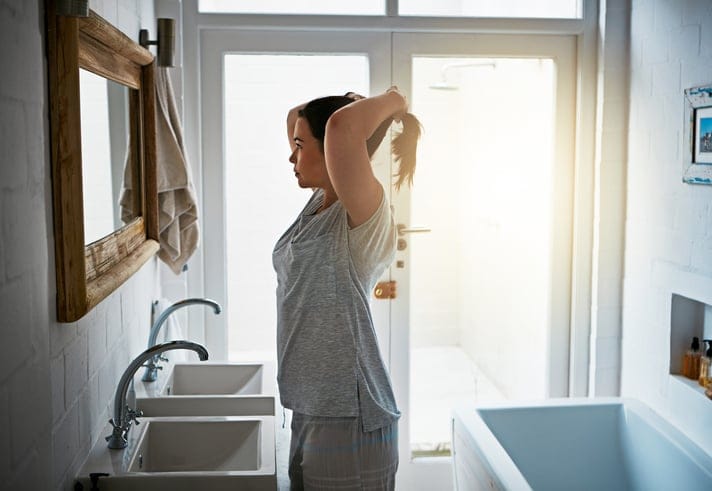Yearly mammograms can spot cancer in your breast before a lump appears, but checking your breasts yourself is important because you get to feel them and look at them for any changes that can signal a problem. However, your self-checks should be more than a quick squeeze and prod. Here are 15 things you should know about checking your breasts correctly every month.
- Look at your breasts. Stand in front of the mirror and look at your breasts. Notice any skin dimpling, or if your breasts have become different in shape or size. Also, check that your nipples aren’t inverted. Is there redness on your skin, or what looks like an orange peel?
- Raise your arms. Now, stay in front of the mirror but raise your arms while you continue looking at your breasts. This can better show what’s happening with and inside them. For instance, moving your arms upwards could force a lump in your breast to pull or dent your skin, which helps you to notice it.
- Keep to the rule of opposites. Now you want to feel your breasts for any changes. If you’re examining your right breast, you want to use your left arm to check it. And vice versa. Keep the other arm above your head. This helps to pull the breast away from the chest wall, so you can better study your breast for any changes.
- Go around in circles. You should feel your breast by gently touching it all over, moving around your breast in a circular motion. It helps to start on the outside of the breast and imagine you’re drawing a circle around your breast. Once you’ve examined your breast in this circular motion, you should move your fingers a little further inside the breast and do the same thing again. It’s like you’re making circles from the outside of your breast all the way to the middle. Moving in circles helps you to cover every part of your breast.
- Don’t press too hard. Self-exams shouldn’t hurt! You want to press lightly with your fingertips. Once you’ve checked both breasts with light fingers, you want to apply a bit of deeper pressure, but again this shouldn’t be painful.
- Feel behind the nipple. As you move your fingers in a circular motion to check your breasts, you want to press behind the nipples. Do this gently without pinching them.
- Don’t squeeze your nipples. You might think it’s good to squeeze your nipples to check for any discharge, but sometimes this releases discharge that’s actually normal. It’s better to look for any discharge that happens normally and avoid squeezing them.
- Move towards the armpit. Once you’ve felt the breast and nipple, you want to move up into the armpit for any swollen or tender lymph nodes that can signal an infection.
- Check other lymph nodes. While you’re at it, press the skin above your collarbone as this will also show if there are sensitive or hard lymph nodes there that sometimes become enlarged when there is cancer or infection in the body.
- If your breasts are big, hold them. If your breasts are big and checking them is difficult, you should support the breast you’re examining by holding it with your other hand. This enables you to press deeper into your breast and examine it all over.
- Take your time. Don’t do a breast check when you’ve got five minutes to spare in the bathroom before rushing out to do other things. You need to take your time and not be distracted so that you check them properly.
- Be consistent. However you check your breasts, whether in the shower, in front of the mirror, or lying down, you should remain consistent with this method as this is the best way to check for any changes on a monthly basis. If you change up your method, you risk missing changes in your breasts or getting confused about what’s normal for your breasts.
- Do it after your period. It’s not a good idea to do a breast check before or during your period as your breasts can feel sensitive or even lumpy during this time due to hormonal changes. Stick to checking your breasts a few days after your period.
- Understand how breasts normally feel. You might feel something a little strange and immediately freak out that you’ve got something wrong with your breasts, but that’s why it helps to know what breasts feel like normally. As breastcancer.org states, breasts have what’s called different neighborhoods. The upper, outer area that’s close to the armpit tends to have the most prominent lumps. The lower half tends to feel like pebbles or sand. Underneath your nipple, you might feel large grains of sand. Who knew?
- Remember: breasts are unique! Knowing how your breasts look and feel tells you what’s normal for you – that’s what’s most important. Then, if there are any changes, you’ll be more aware of them much sooner. Even if the changes are a sign of breast cancer, it’s reassuring to know that the five-year survival rate for women with Stage 0 or Stage 1 breast cancer is close to 100 percent. So go on and give your breasts some love every month!



